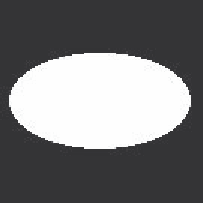Image Processing Reference
In-Depth Information
When the pixels (
x
i
,
y
i
) and (
x
i
-1
,
y
i
-1
) are 4-neighbours (as shown in Figure
7.1
(a)), the
summation term is unity. Otherwise, the summation term is equal to 2. Notice that the
discrete approximation in Equation 7.69 produces small errors in the measured perimeter.
As such, it is unlikely that an exact value of 2π
r
will be achieved for the perimeter of a
circular region of radius
r
.
Based on the perimeter and area it is possible to characterise the compactness of a
region.
Compactness
is an oft-expressed measure of shape given by the ratio of perimeter
to area. That is,
4( )
()
As
Ps
CS
() =
(7.70)
2
In order to show the meaning of this equation, we can rewrite it as
As
Ps
()
()/4
CS
() =
(7.71)
2
Here, the denominator represents the area of a circle whose perimeter is
P
(
S
). Thus,
compactness measures the ratio between the area of the shape and the circle that can be
traced with the same perimeter. That is, compactness measures the efficiency with which
a boundary encloses an area. For a circular region (Figure
7.19
(a)) we have that
C
(
S
)
1
(Figure
7.20
). This represents the maximum compactness value. Figures
7.19
(b) and (c)
show two examples in which compactness is reduced. If we take the perimeter of these
regions and draw a circle with the same perimeter, then we can observe that the circle
contains more area. This means that the shapes are not compact. A shape becomes more
compact if we move region pixels far away from the centre of gravity of the shape to fill
empty spaces closer to the centre of gravity. Note that compactness alone is not a good
discriminator of a region; low values of
C
are associated with involuted regions such as the
one in Figure
7.19
(b) and also with simple though highly elongated shapes. This ambiguity
can be resolved by employing additional shape measures.
(a) Circle
(b) Convoluted region
(c) Ellipse
Figure 7.19
Examples of compactness
Another measure that can be used to characterise regions is dispersion. Dispersion
(irregularity) has been measured as the ratio of major chord length to area (Chen, 1995).
A simple version of this measure can be defined as
























